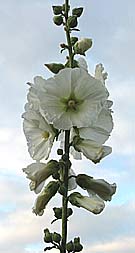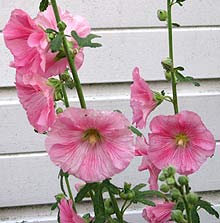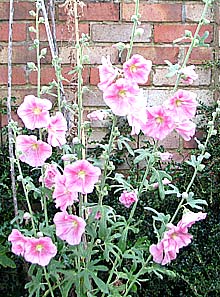Growing Hollyhock - A Cottage Garden favourite
SEASONAL TIPS
Spring - start seeding and planting hollyhocks
For early flowers start annual hollyhocks indoors 8 weeks before the last
frost.
Sow seed in peat pots and keep at 15C.
Don't exclude light- this aids seed germination.
Transplant hollyhock seedlings or container grown plants to the garden
flower border after the last frost.
Summer - Feeding
As flower buds appear feed hollyhock plants with a liquid fertilizer.
Autumn-
When flowering is finished cut back the tall stem at ground level
to prevent the chance of hollyhock rust overwintering.
You may be lucky and get blooms the following year.
POPLUAR HOLLYHOCK VARIETIES
Alcea Rosea Nigra - Tall stems with almost black maroon flowers.
Appleblossom - double hollyhock with pink flowers.
Peaches n Dreams - Double peach coloured blooms.
Chater's Double Icicle - large, fully double, crystal white, powder-puff flowers.
Indian Spring - a single flowered hollyhock in mostly
rosy shades of red with some yellows.
PLANT SOCIETIES
HOLLYHOCK - ALCEA ROSEA
 During July and August there is no plant which adds so much to the stateliness
of the flower garden as the Hollyhock.
During July and August there is no plant which adds so much to the stateliness
of the flower garden as the Hollyhock.
Once you have planted hollyhocks in your garden, they will require very little care, however there are just a few things you should be aware of when cultivating hollyhocks. Here are a few useful tips on growing hollyhocks sucessfully.
Hollyhock flowers, which are produced in rich and delicate colours, from the deepest crimsons and maroons, to blush pinks, whites and pale yellows, are borne in a long succession on tall stems 1 - 3 metres high.
HOLLYHOCKS ARE BIENNIALS
Most hollyhocks are technically biennials - producing leaves the first year and flowers the next.
However with good care they often last longer than two years and so can be described as short lived perennials.
The life of a hollyhock plant can be lengthened by removing flowers as they fade.
Although short lived hollyhocks have the benefit of freely reseeding themselves, providing a splendid display of flowers year after year.
WHERE TO PLANT HOLLYHOCKS
The beauty of the hollyhock flower is much enhanced when displayed against a background such as a grey wall, fence,tall green hedge or a border of evergreen shrubs - yet hollyhocks should not really be planted close to hedges or shrubs as they both usually have very hungry roots which will take the nutrients needed by the hollyhock plant.
TOWN OR COUNTRY FLOWERS
Hollyhocks seem especially at home in country towns and suburbs and thrive well in corners and narrow flower borders near walls where they are protected in the winter from execessive wet conditions. They are very drought resistant.
The small annual hollyhock 'Majorette Mixed' which has large semi-double blooms is ideal to grow in a flower border with other annuals and perrenials.
The hollyhock is a favourite in the cottage garden
GROWING HOLLYHOCKS FROM SEED
 Many
growers rely entirely on plants raised from seed the previous summer,
or during February and march for flowering in July and August.
Many
growers rely entirely on plants raised from seed the previous summer,
or during February and march for flowering in July and August.
When hollyhocks are grown quickly in this way they escape many chancs of infection with hollyhock rust or other diseases..
Hollyhock seed is large, and if you buy packets of seed, the number of seeds in a packet is relatively small - so it is best to sow the seed in trays filled with sandy soil to within 1 cm of the rim then cover with 1 cm of soil or seed compost.
Place the seed trays in a cold frame and shade them if the weather is warm.
SOWING HOLLYHOCKS IN SPRING
When sowing in spring a greenhouse or warm frame is an advantage.
If space is limited, hollyhocks may be sown more thickly and transplanted as soon as they show a true leaf - either into trays or singly into small pots. Grow on and harden off carefully.
CARE OF HOLLYHOCK PLANTS
As hollyhocks grow to a great height and are often exposed to the full force of the wind it is best to provide strong stakes as support.
 Hollyhocks
love a deep, rich, loamy soil - but they will often thrive without it.
Hollyhocks
love a deep, rich, loamy soil - but they will often thrive without it.
If you water hollyhocks during the summer months give them a thorough soaking, followed by a mulch of well rotted manure.
There is a long succession of flowers, and as the lower blooms fade they should be picked off so that the plant is not weakened by the production of seed.
When flowering is over for the season the plants may be cut down to about 15 - 20 centimetres high and the stump covered withcoal ashes, if available. This keeps the slugs and snails away and causes water to drain away from the soft stem.
If taken care of in this way, hollyhock plants will often last for several years.
PROPAGATING YOUNG PLANTS
A stock of young plants of a favourite variety of hollyhock can easily be raised by selecting short side shoots form the base of a plant during September and October.
Insert the shoots into clean pots or trays of potting compost and place in a closed shaded frame until the leaves become plump - a small amount of ventilation can then be given; too much ventilation will cause the leaves to wither.
As soon as the shoots have rooted give full light and air.
USEFUL ARTICLES ON GARDEN GROWER
How to grow all types of Hollyhocks - a favourite flower for the cottage garden. Expert advice on seasonal care and growing tips on growing a hollyhock plant from seed or young plants.